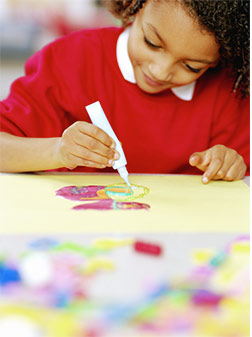
Learning vocabulary may not be the most exciting thing students do school, but by using interesting and fun ways to teach vocabulary words, educators can increase student interest and help with both memorization and retention. Below are several techniques teachers should consider when teaching vocabulary.
Drawing
 When it comes to teaching vocabulary words to younger students, there are plenty of easy options. Coloring pages and picture books help students visualize the words that they are being taught, which helps with comprehension. While older students may not be interested in coloring or reading storybooks, they too benefit from visual stimulation. That’s why writing words out or creating flashcards helps in memorization of vocabulary words.
When it comes to teaching vocabulary words to younger students, there are plenty of easy options. Coloring pages and picture books help students visualize the words that they are being taught, which helps with comprehension. While older students may not be interested in coloring or reading storybooks, they too benefit from visual stimulation. That’s why writing words out or creating flashcards helps in memorization of vocabulary words.
Teachers who want to up the creativity level and really ingrain vocabulary into student’s minds might want to kick it up a notch by having students draw an image of each vocabulary word. By encouraging students to make images funny, teachers increase the chance these visual learning devices will be memorable.
Online Videos
Another visual way to teach vocabulary is to find videos that showcase the words used in lesson. Videos created for people learning English as a second language are also ideal for teaching younger students words with which they have had little or no exposure. YouTube Teachers’ Language Arts section is a good place to look for video content that is safe for classroom viewing.
Brainstorm
 Vocabulary builds upon itself, and association with words that are already familiar to students is one of the most effective means of teaching students unfamiliar words. Teachers who help students associate new words with words they already know well will help students with long-term retention.
Vocabulary builds upon itself, and association with words that are already familiar to students is one of the most effective means of teaching students unfamiliar words. Teachers who help students associate new words with words they already know well will help students with long-term retention.
One method of associating vocabulary words with familiar words is to brainstorm with students. Once students have heard a word and its definition, teachers can write the word on the board and ask students to say words that go along with the new vocabulary word. If the word is “mare,” for instance, students might say “horse,” “barn” and “hay.” By writing the words down together, it creates a visual reference for students.
Act it Out
 Younger children, especially, respond to games, but older kids don’t generally mind a little injection of fun into their school days either. Teachers can make vocabulary words more fun to learn by turning the process into a game, like charades.
Younger children, especially, respond to games, but older kids don’t generally mind a little injection of fun into their school days either. Teachers can make vocabulary words more fun to learn by turning the process into a game, like charades.
Students can take turns acting out one of the vocabulary words, while the other students guess the word. In order for charades with vocabulary words to work, students need some basis in the vocabulary, so teachers should schedule the game of charades a few days after students first get their vocabulary words. Teachers may want to release the word list on Monday, for instance, and make Friday game day.
Write a Story
 A larger vocabulary enhances students’ writing and reading abilities, so what better way for students to retain words than to use them in stories? Teachers can assign stories on an individual basis, or make it a class project.
A larger vocabulary enhances students’ writing and reading abilities, so what better way for students to retain words than to use them in stories? Teachers can assign stories on an individual basis, or make it a class project.
By having students incorporate all their vocabulary words correctly into the text, students get the opportunity to learn proper spelling and definitions, and also how to use the words in context.
Word of the Day
Educators who grew up in the 1980s surely remember “Pee-Wee’s Playhouse” and “Pee-Wee’s Word of the Day.” When the word of the day was spoken, everyone in the playhouse, and the kids at home, were supposed to scream.
Teachers who want to encourage students to use their new vocabulary words (and who can stand a little noise) could benefit from this method. Teachers can make each day’s word of the day a different vocabulary word, and let students yell whenever someone says it. Then, at the end of the yell, teachers can remind students of the word’s definition.
Even teachers will admit vocabulary isn’t the most exciting thing to teach, but adding fun ways to teach vocabulary words can help keep the process fresh and entertaining.
Categorized as: Tips for Teachers and Classroom Resources
Tagged as: Early Childhood and Elementary (Grades: PreK-5), Engaging Activities, Language Arts
